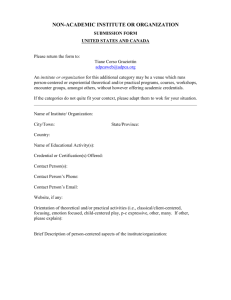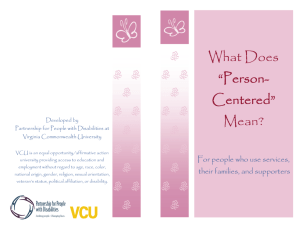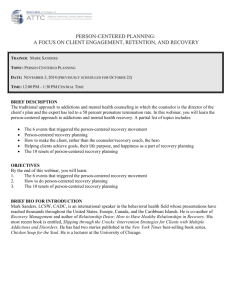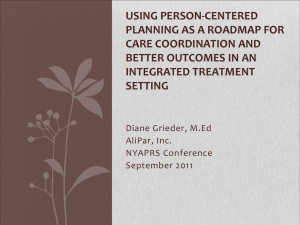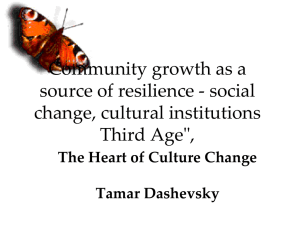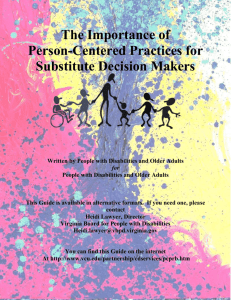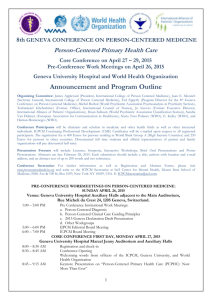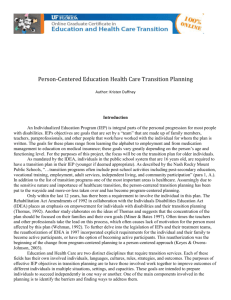Personal and Employment Outcomes of Person
advertisement
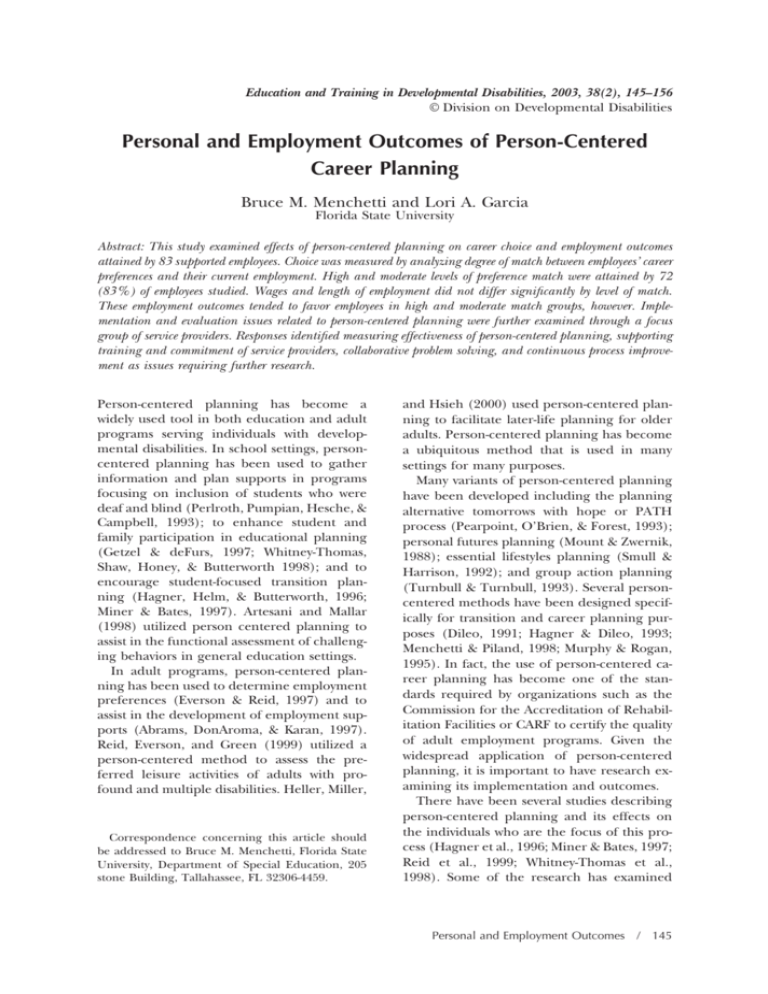
Education and Training in Developmental Disabilities, 2003, 38(2), 145–156 © Division on Developmental Disabilities Personal and Employment Outcomes of Person-Centered Career Planning Bruce M. Menchetti and Lori A. Garcia Florida State University Abstract: This study examined effects of person-centered planning on career choice and employment outcomes attained by 83 supported employees. Choice was measured by analyzing degree of match between employees’ career preferences and their current employment. High and moderate levels of preference match were attained by 72 (83%) of employees studied. Wages and length of employment did not differ significantly by level of match. These employment outcomes tended to favor employees in high and moderate match groups, however. Implementation and evaluation issues related to person-centered planning were further examined through a focus group of service providers. Responses identified measuring effectiveness of person-centered planning, supporting training and commitment of service providers, collaborative problem solving, and continuous process improvement as issues requiring further research. Person-centered planning has become a widely used tool in both education and adult programs serving individuals with developmental disabilities. In school settings, personcentered planning has been used to gather information and plan supports in programs focusing on inclusion of students who were deaf and blind (Perlroth, Pumpian, Hesche, & Campbell, 1993); to enhance student and family participation in educational planning (Getzel & deFurs, 1997; Whitney-Thomas, Shaw, Honey, & Butterworth 1998); and to encourage student-focused transition planning (Hagner, Helm, & Butterworth, 1996; Miner & Bates, 1997). Artesani and Mallar (1998) utilized person centered planning to assist in the functional assessment of challenging behaviors in general education settings. In adult programs, person-centered planning has been used to determine employment preferences (Everson & Reid, 1997) and to assist in the development of employment supports (Abrams, DonAroma, & Karan, 1997). Reid, Everson, and Green (1999) utilized a person-centered method to assess the preferred leisure activities of adults with profound and multiple disabilities. Heller, Miller, Correspondence concerning this article should be addressed to Bruce M. Menchetti, Florida State University, Department of Special Education, 205 stone Building, Tallahassee, FL 32306-4459. and Hsieh (2000) used person-centered planning to facilitate later-life planning for older adults. Person-centered planning has become a ubiquitous method that is used in many settings for many purposes. Many variants of person-centered planning have been developed including the planning alternative tomorrows with hope or PATH process (Pearpoint, O’Brien, & Forest, 1993); personal futures planning (Mount & Zwernik, 1988); essential lifestyles planning (Smull & Harrison, 1992); and group action planning (Turnbull & Turnbull, 1993). Several personcentered methods have been designed specifically for transition and career planning purposes (Dileo, 1991; Hagner & Dileo, 1993; Menchetti & Piland, 1998; Murphy & Rogan, 1995). In fact, the use of person-centered career planning has become one of the standards required by organizations such as the Commission for the Accreditation of Rehabilitation Facilities or CARF to certify the quality of adult employment programs. Given the widespread application of person-centered planning, it is important to have research examining its implementation and outcomes. There have been several studies describing person-centered planning and its effects on the individuals who are the focus of this process (Hagner et al., 1996; Miner & Bates, 1997; Reid et al., 1999; Whitney-Thomas et al., 1998). Some of the research has examined Personal and Employment Outcomes / 145 implementation of person-centered planning, and whether the person-centered strategy in question has been utilized appropriately (Roberts, Becker, & Seay, 1997). Other studies have assessed the personal empowerment effects of person-centered strategies, especially as a method for involving people with more extensive support needs in assessment and planning activities (Reid et al., 1999). For example, Roberts et al. (1997) monitored the adoption and implementation of person-centered planning by an agency serving people with mental retardation and mental illness. This agency utilized person-centered planning with 27 employees of a sheltered workshop. Roberts et al. found that agency personnel who attended the greatest number of training sessions were implementing person-centered planning at its highest level of use. These researchers also found that it was a sense of obligation on the part of service providers that was most predictive of action towards innovative ideas such as person-centered planning. Those providers who agreed with person-centered values and had a sense of obligation towards operating in new ways were also the ones who moved furthest in their adoption of person-centered planning techniques. The work of Roberts et al. suggested that training, which emphasized values and commitment to change in service delivery, as well as the specific steps of a new planning method, led to the highest level of person-centered planning implementation by personnel. In an attempt to better measure both the implementation and outcomes, Holburn, Jacobson, and Vietz (2000) reviewed existing evaluation instruments and surveyed experts to construct new measures of person-centered processes and accomplishments. The six factors identified as influencing implementation of person-centered processes were: clear delineation of roles, personal relationship with the focus person, desire for change, creation of a personal vision, commitment to planning and follow-up, and flexibility of resources. Holburn et al. suggested nine outcome areas be used to evaluate person-centered planning. These were enhancement of: autonomy and choice-making, home life, work and day activities, health, relationships, community places, respect, competence, and overall life satisfaction. 146 / Others have suggested that person-centered planning can increase choice and personal empowerment for people (Butterworth, Steere, & Whitney-Thomas, 1997; Marone, Hoff, & Helm, 1997). Reid et al. (1999) examined how accurate person-centered planning was in assisting adults to make choices about preferred items and activities. The adults who participated in this study were non-ambulatory due to their multiple physical disabilities. They were also labeled as having profound mental retardation. Like many individuals with these challenges and labels they resided in a residential facility and spent their days in an adult day program. Reid et al. trained staff in these settings to facilitate person-centered planning meetings with the purpose of assisting individual to make choices and identify preferred items and activities. The researcher used a direct behavioral observation technique called systematic preference assessment (SPA) to evaluate the degree to which items and activities reported to be preferred in person-centered planning were actually selected for use or “sampled” during the SPAs. SPA results indicated that two adults sampled 100% of items and activities chosen during their person-centered planning. Reid et al. suggested this level of selection represented high or moderate correspondence or “preference match” between person-centered planning and systematic preference assessment. The remaining two adults in this study sampled 76% and 60% of the items and activities chosen during their person-centered meetings. As a result of this investigation Reid et al. recommended evaluating the accuracy or validity of person-centered planning by conducting brief SPAs while simultaneously using person-centered planning to assist people in making choices and identifying preferences. Whitney-Thomas et al. (1998) studied the level of student involvement in person-centered educational planning. They observed a range of student participation from “absent” or “limited” to “in control” and “active.” Whitney-Thomas et al. concluded that person-centered planning, while holding some promise for involving students more in their educational plans, was influenced by several factors. These factors included the student’s conversational style, size of the meeting, level of abstraction in discussions, and expectations and behaviors of meeting participants. Education and Training in Developmental Disabilities-June 2003 In summary, research has indicated that there is still wide variation in implementation of person-centered planning and subsequent personal empowerment outcomes. However, there is some evidence that, with appropriately designed training and commitment of providers, personnel can implement personcentered planning faithfully and reliably (Roberts et al., 1997). In addition, research has suggested that person-centered planning may hold some promise as a useful tool for assessing valid preferences and choices (Reid et al., 1999). For many years authors have suggested that autonomy in choice-making can lead to lifestyle enhancement for individuals who have been denied this basic human right in the past (O’Brien, 1987; Schalock, 1996). More research is needed, however, to establish validity of person-centered planning to accomplish other assessment purposes and enhance other lifestyle outcomes. Such research could further establish person-centered planning as a viable and valid alternative to more traditional assessment and planning techniques such as psychometric tests, adaptive behavior scales, and standardized work samples. These traditional techniques are still used by schools and adult agencies to assess and plan for people with the most extensive support needs, even though use of such approaches with this population has been criticized for many years (Kozloff, 1994; Menchetti & Udvari-Solner, 1990; Murphy & Hagner, 1988; O’Brien & O’Brien 1992; Parker & Schaller, 1996). Research on person-centered planning may provide some of the empirical evidence needed to replace ineffective and nonfunctional traditional techniques with a method that has shown promise for enhancing lifestyle outcomes for individuals with extensive support needs. The purposes of this study were to examine the validity of a person-centered career-planning tool called the Personal Career Plan (Menchetti & Piland, 1998, 2001) and to identify perceptions of employment consultants who use it. The stated purposes of the Personal Career Plan or PCP are to enhance career choice and employment outcomes for adults served in supported employment programs. This study examined whether the PCP accomplished these two purposes for a group of adults served by a supported employment program. It also explored, through focus groups with employment consultants, insights regarding implementation and usefulness of person-centered career planning. Method: Outcomes of Personal Career Planning Participants One hundred and two individuals receiving supported employment services from a local adult agency were identified as potential participants for this study. After reviewing agency records, 83 supported employees’ files had sufficient data to conduct analyses needed to analyze outcomes related to career choice and employment. There were 37 women and 46 men, with a mean age of 32 years, in the participant group studied. The majority of participants (78%) were previously labeled as having mental retardation, and of these, 35% scored 59 or below on a standardized intelligence test. Participant characteristics and disability labels used to represent people in the study can be found in Tables 1 and 2. National research on the implementation of supported employment (Wehman & Kregel, 1995) suggested that supported employees across the United States had the same types and levels of disabilities as those reported by participants in this study. TABLE 1 Participant Characteristics by Level of Preference Match Preference Match Level Characteristics Age mean median mode Gender Male Female High (n ⫽ 48) Mod (n ⫽ 24) Low (n ⫽ 11) 31 28 21 34 33 31 35 32 20 22 26 15 9 9 2 Personal and Employment Outcomes / 147 TABLE 2 Participant Disability Labels by Level of Preference Match Preference Match Level Assigned Labels Autism Cerebral Palsy Learning Disability Mental Illness Mental Retardation Organic Brain Disorder Pervasive Developmental D/O Physical Impairment Prader-Willi Syndrome IQ Score 82–70 69–60 59 or below not available High Mod Low (n ⫽ 48) (n ⫽ 24) (n ⫽ 11) 1 3 4 0 36 1 0 0 3 19 0 0 0 1 10 0 1 0 1 2 0 0 0 0 1 0 0 5 16 16 11 1 6 9 8 2 4 4 1 Setting The adult agency providing supported employment services to participants in this study was a local ARC. The ARC was fully and currently accredited for its supported employment programs by the Commission on Accreditation of Rehabilitation Facilities (CARF), a national rehabilitation accreditation organization. In an arrangement that is commonplace in most American communities, this ARC received funding for supported employment from the state Division of Vocational Rehabilitation and the state Developmental Disabilities Program Office. At the time of this study the ARC had 9 employment consultants serving, on average, 100 supported employees in nine counties in North Florida. Among the services provided, employment consultants assisted supported employees with person-centered career planning using the Personal Career Plan. Based on results of their career plans, people were assisted with the job application and interview process. In addition, ARC employment consultants provided on-the-job-training and fol- 148 / low-along support after individuals secured employment. Once again earlier research on supported employment suggested that funding and services provided by the ARC in this study represent standard practices in supported employment services nationwide (Kregel, 1998; Wehman & Kregel, 1995). The Personal Career Plan The Personal Career Plan or PCP is a variation of person centered planning developed specifically to assist schools and adult agencies with transition and career planning (Menchetti & Piland, 1998, 2001). This method involved formation of a support group that met with the potential supported employee (and family, when appropriate) to discuss his or her career preferences, skills, and support needs. The PCP meeting produced an action plan designed to achieve the career goal (i.e., vision statement) expressed by the potential employee during the meeting. The ARC employment consultant, who could reconvene the planning group to review efforts and make adjustments as needed, provided ongoing support for personal career planning. The PCP represents a career planning approach that is widely available to adult employment agencies in various forms (e.g., DiLeo, 1991). More importantly, the PCP included all of the elements commonly associated with person centered planning in the literature (Butterworth et al., 1997; Kregel, 1998). Career Choice Information Information about career choices expressed by participants in this study came from an analysis of the vision statement section of their PCP. The congruence or match between an individual’s expressed choice and their eventual employment was determined using the preference matching procedures described below. Vision statement. One of the primary purposes of the PCP is the development of the vision statement, which is written in the first person (e.g., “I want . . .”). In this study, the vision statement provided the mechanism for identifying the preferred career choice of individuals participating in the PCP process. Using ARC records, participant PCPs were re- Education and Training in Developmental Disabilities-June 2003 viewed and their vision statement was recorded in a database. Preference match procedures. Preference match was operationally defined as the level of match (high, moderate, or low) between the individual’s expressed career choice and their current job. The current occupational title and job location were considered in determining the degree or level of preference match. A person who was presently employed in the identical occupation and location expressed in his or her career plan was assigned a “high” preference match level. People assigned a “moderate” level of preference match were typically employed in a related occupation and location, and those who were employed in a different occupation and location were assigned a “low” level of preference match. For example, if a person’s vision statement was, “I want to work as a baker’s assistant at the Publix (grocery) near my house,” a high level of preference match was assigned if both the person’s current occupation was identical (baker’s assistant), and the current location was identical (Publix near home). However, if the person’s current occupation was related to their choice (e.g., a counter server/cashier), and they were at a related location (e.g., the bakery counter at a Winn Dixie grocery), a moderate preference match level was assigned. Finally, if the person’s current occupation was a dishwasher and the job was located in a Pizza Hut restaurant, a low level of preference match was assigned, since the current occupation and location were entirely different from those expressed in the person’s vision statement. In the event that a person’s vision statement did not reflect a specific occupational title or location, other information was used to determine the preference match level. Measurable aspects of a person’s vision statement were compared with their current employment status, and preference match level was assigned based on the congruence between expressed preferences for hours, benefits, wages, and other employment conditions and the person’s current job situation. For example, a person whose vision statement was, “I want a permanent position with benefits,” was assigned a “high” level of preference if their current employment status (e.g., full-time job with benefits) was identical to their expresses preference for wages, hours, and employment conditions (e.g., benefits). Employment Data Current employment records maintained by the ARC were used to generate the wage and hour statistics analyzed in this study. Monthly employment reports were used to collect data on each participant’s current hourly wage, hours worked per month, number of consecutive months employed, and the person’s current monthly earnings. Individual participant data were entered into a database and statistics describing wages and length of employment for the entire group of 83 participants were generated using SPSS. Process Implementation Data Similarly, data about implementation of the PCP were collected from agency records. These records were used to identify initial career plan dates, number of, and dates for, career plan updates, and the people who attended the PCP meetings. Again, individual participant data were entered into the database and SPSS was used to produce descriptive statistics. Method: Implementation Issues Identified by Focus Group Participants Six employment consultants (EC) or job coaches, who were responsible for facilitating Personal Career Plans and implementing supported employment services, served as participants in the focus group. There were 2 male and 4 female ECs, with an age range of 24 to 58 years. EC’s job experience ranged from 9 months to 15 years, with a mean of 6 years of experience as an employment consultant. Five of the six ECs had specific training in supported employment, two had formal, internal (i.e., provided by agency) training specific to the Personal Career Plan, and all EC had some type of general, external training in person-centered approaches (i.e., conferences). Additionally, experienced ECs typically attended the first few PCP meetings facilitated by the new ECs. Personal and Employment Outcomes / 149 Focus Group The focus group was held at a time and location convenient for participants (the ARC office), and it lasted for approximately two hours. Format for the focus group was based upon guidelines set forth by Krueger and Casey (2000), and included short, open-ended, one-dimensional questions. A single category design (Krueger & Casey) was implemented, during which the purpose was to gain insight regarding implementation and outcome evaluation issues associated with person-centered career planning. ECs were provided with a guide consisting of questions and data for discussion. Responses were grouped (to preserve confidentiality) and recorded on a large flip chart. Rationale behind the focus group was to enhance and validate information and conclusions drawn from the quantitative data described earlier in this study. rent employment status, the moderate match category was used when there were identical matches in one aspect (occupation or location), but not both aspects of a person’s current employment situation. For example, two people assigned to the moderate match category had identical occupations but obtained employment in a different location, while five people in this category obtained work in locations identical to their expressed choice, but were employed in different occupations. Finally, eleven people (13%) were assigned a “low” preference match level, because they were employed in a different occupation and either a related or different location (see Table 3). Overall, 72 people (87%) who participated in person centered planning obtained employment in an occupation and/or location that were identical or related to the career choices expressed in their vision statement the Personal Career Plan. Results Career Choice Outcomes Employment Outcomes by Level of Preference Match Table 3 depicts levels of preference match assigned to study participants by occupational title and job location. Of the 83 participants in this study, 48 (58%) people were assigned a “high” level of preference match. In other words, these individuals obtained employment in the identical occupation and location expressed in the vision statement of their Personal Career Plan. Twenty-four people (29%) achieved a “moderate” level of preference match - they obtained employment in an occupation and location that were related to their expressed career choices. In order to provide a conservative estimate of the level of congruence between career choice and cur- As illustrated in Table 4, study participants varied slightly on hourly wages, months employed, hours worked per month, and monthly earnings. Generally, all employment outcome measures favored participants in the high and moderate match categories. Wages. Hourly wage rates varied by level of preference match. Participants in the high and moderate match categories averaged higher hourly wages than participants in the low match category. However, the medians and modes for hourly wages did not differ much between preference match categories. Monthly earnings, however, seemed to slightly favor those participants in the high and mod- TABLE 3 Assigned Level of Preference Match Location Occupation Identical Related Different Identical Related Different High PM (n ⫽ 48) Moderate PM (n ⫽ 5) Moderate PM (n ⫽ 5) Moderate PM (n ⫽ 0) Moderate PM (n ⫽ 12) Low PM (n ⫽ 0) Moderate PM (n ⫽ 2) Low PM (n ⫽ 0) Low PM (n ⫽ 11) PM ⫽ Preference Match; n ⫽ number of participants assigned to each level. 150 / Education and Training in Developmental Disabilities-June 2003 TABLE 4 Selected Employment Outcomes by Level of Preference Match Employment Outcomes Hourly Wage Preference Match Levels High: Identical Occupation/Location (n ⫽ 48) mean median mode range Moderate: Related Occupation/Location (n ⫽ 24) mean median mode range Low: Different Occupation/Location (n ⫽ 11) mean median mode range a Months Employed Monthly Hours Worked Monthly Earnings $6.11 $5.85 $5.15 $5.15–$8.00 44 37 10a 1–154 105 99 173 26–173 $652.15 $592.50 $479.00a $152–$1384 $6.49 $6.25 $6.00 $5.15–$9.50 52 35 12a 1–205 118 119 173 52–173 $799.25 $675.50 $390.00a $338–$1644 $6.00 $5.80 $5.15a $5.15–$7.25 37 29 ⬎1a ⬎1–104 103 87 173 26–173 $627.00 $609.00 $143.00a $143–$1254 Multiple modes exist. The smallest value is shown. erate match categories. The 72 (87%) of participants who obtained a high and moderate match between their expressed career choices and their current employment, earned more per month on average than their counterparts who had low match between career choices and current employment. When high and moderate match participants are viewed as a single group, wage differences between the newly combined group and the low preference match group increased. The average hourly wage earned by the high and moderate group was $6.24 versus $6.00 for low match participants. Similarly, average monthly earnings were $701.18 for high and moderate match participants versus $627.00 for those assigned a low level of preference match. Length of employment. Length of employment varied slightly by degree of congruence between expressed career choice and current employment situation. For example, the median months of consecutive employment for people with a high, moderate, and low preference match level was 37, 35, and 29, respectively. The median level of monthly hours worked also varied match level. High, moderate, and low preference match participants obtained medians of 99, 119, and 87, respectively. In terms of total number of months employed and hours worked per month, findings of this study slightly favor participants who obtained a high-to-moderate level of congruence between their expressed career choices and their current employment situation. Participants in the combined high and moderate match categories averaged 109 hours worked per month versus 102.55 hours per month for participants with low levels of preference match. High and moderate match participants averaged 47 months of continuous employment versus 37 months for the low match participants. Personal Career Plan Implementation Findings Review of the 83 personal career plans revealed that the average number of people attending the meeting, not including the supported employee, was three. Usually the attendees were the EC, a family member, and another professional (e.g., support coordinator, vocational rehabilitation counselor). Thirty-nine people (47%) of those receiving a PCP had not received an annual update of Personal and Employment Outcomes / 151 their person-centered plan, 40 people (48%) received one update, and four people (5%) received two updates since the initial PCP meeting. “Updates” typically consisted of updating the first page (e.g., address, phone numbers, people attending meeting) and the last page (e.g., vision statement, plan/tactics). On average, months since last PCP update was 18, and for 38 people (57%) it had been more than 12 months since their last PCP update. Focus Group Findings Results of the focus group indicated that the majority of ECs believed the greatest strengths of the PCP included its “. . . use with completion of job applications,” remarking, “It has a lot of information that is helpful.” ECs also pointed out the following about the PCP: “It is a source of empowerment for consumers,” “It creates a sense of ownership in the job,” and “It gathers service professionals with expertise and provides real support.” Finally, the PCP was identified as an instrument, which: “. . .focuses on strengths,” “. . .is a good training tool for self-advocacy,” and “. . .it serves as a tool to advocate for others.” The greatest barriers to using the PCP when planning for employment with consumers, according to ECs, included difficulty with explaining the concept of “vision statement,” and using information collected during the PCP (e.g., “dream job”) to write a person’s vision statement. ECs also pointed out that there are many systemic impediments to a person-centered approach to career planning. ECs declared, “The person-centered planning philosophy is not always practiced,” elaborating, “Support coordinators and supported living counselors tend to dominate meetings, because they are planning for the person’s entire life. I have to ask during the [annual] support plan meeting, ‘do you mind if I ask a few questions so I can complete my paperwork, too?” Finally, ECs remarked, “It [PCP] becomes a ‘form-filling meeting’ during which people are being ‘micro-managed’. . .. It’s a system- versus person-centered process.” These results are consistent with concerns expressed by Mount (1994) regarding potential breakdowns of person centered planning. One phenomenon that can impede the person-centered planning process is stress on agency personnel for “standardization and ef- 152 / ficiency.” According to Mount (1994), attempts to standardize planning results in a process, which becomes system- versus personcentered. The importance of team dynamics, as highlighted by the ECs, is also reflected in current literature. For example, results of work groups conducted by Schwartz, Jacobson, and Holburn (2000) revealed that flexibility is an important quality of person-centered plans and teams. Such flexibility refers to plans, which reflect changes as needed, as well as team members who adapt to adjustments in each other’s roles in order to meet the person’s goals (Schwartz et al.). When ECs were asked what the best outcome measure(s) of person-centered career planning were, responses included: “Did you reach their vision statement; it’s the only thing that tells you what people want,” “When people begin to advocate for themselves, make informed choices,” and “Responses from satisfaction survey.” These remarks seem to suggest career choice and preference match as two important outcomes to measure when evaluating person-centered planning. Next, ECs were shown data describing participant characteristics (Tables 1 and 2) and employment outcomes (Table 4). Following data presentation, ECs were asked to provide insights and observations regarding data, which yielded a variety of responses. For example, many of the ECs pointed out that “. . .monthly wages for most will be $740 or less, because of SSDI and SGA, too,” and remarked that “The reason people want 20-25 hours per week is because of the primary concern of supported employees, voc rehab counselors, and support coordinators: ‘What will happen to services’ such as Medicaid.” Finally, one EC described a supported employee who “. . .will lose eligibility for implant if works more than 10-15 hours per week” and stated “The only people who want to work fulltime are typically people with no SSI, SSDI, Medicaid, and are usually from VR.” These responses suggest that employment outcomes such as wages and hours worked need to be viewed in the context of other supports received by people, especially those provided by social security programs. After presentation of preference match data (see Table 3), ECs offered insights and suggestions for evaluating the effectiveness of person-centered career planning. One EC Education and Training in Developmental Disabilities-June 2003 asked, “Does [sic] the 11 people [who had low preference matches] include the person who wanted to be a band conductor?” Exploration of this response revealed, “. . .some people confuse ‘dream job’ with the vision statement.” ECs clearly indicated the need to provide support to people during the implementation of person-centered planning. Consistent with recommendations from the work groups conducted by Schwartz et al. (2000), language in person-centered plans should be simple and understandable and reflective of the person’s goals, whether about daily issues or future, life-defining visions. The last set of data shown to the ECs was information specific to implementation of the PCP, after which they were asked to offer suggestions for its enhancement. Regarding number attending PCP meetings, ECs remarked, “It depends on whether you’ve been invited to the support plan meeting. . .could have own meeting but everyone is so burned out on meetings, so we coordinate with their meetings.” Regarding updates, ECs stated, “There’s never been any clarification about the updates, when we should do them or how.” Following up on this issue, ECs were asked, “When are updates typically done?” to which they responded: “When there is significant change, for example, moving, job description, title, or job in general changes,” “. . .long length of time since initial PCP, for example, 3-5 years,” “. . .poorly done PCP,” and “If you accomplish that vision statement, then you need another.” Mount (1994) described “seduction of the quick fix” as the most common breakdown in person-centered planning and implementation. The quick fix is characterized by over emphasis on the first meeting with little to no attention to follow-up and revitalization. Further, Everson and Zhang (2000) also conducted focus groups on person-centered planning and found that maintaining activities over time was a common challenge. Remarks by ECs about implementation issues are reflective of those described in the literature and suggest need for more staff training and commitment to continuous updating of career planning. ECs also commented on the PCP, in general, stating, “We need an exact way to explain the vision statement,” “When we give examples, its seems like we are leading them, telling them what to say,” “We have problems with vision statement versus simply asking ‘What job do you want,’” and “The ‘vision statement’ is too abstract for people with developmental disabilities and cognitive impairments.” One EC concluded by stating, “This is fancy, clinical language of people who sit in offices and don’t work with people; its to satisfy people other than the supported employees. They don’t talk like that and don’t understand it. How is this person-centered planning?” This reinforces earlier comments, as well as recommendations found in current literature, emphasizing the need for person-centered plans to reflect language and goals that are meaningful to the individual. The difficulty with the vision statement, as expressed by ECs during the focus group was explored through the following inquiry: “How do you usually find out what kind of job a person wants? What do you ask about?” To which the ECs replied, “We ask specific questions about days, weekends, hours, uniforms. . .” and, “During the situational assessment, we do a flexibility form, and ask about these kinds of things.” ECs indicated that they could use these items during the PCP to help clarify the vision statement for their consumers. In addition, ECs made some specific recommendations for the Personal Career Plan, including: “We could introduce the ‘dream job’ statement at the beginning of the meeting and leave the ‘vision statement’ where it is, following the work history, etc.” ECs also requested that they have more formal, internal trainings on the PCP and person-centered career planning, in general. Overall, ECs concluded that the PCP was “. . .a good process for the good of the consumers” and “It provides choice, empowerment, self-advocacy,” declaring that, “It’s a worthwhile process.” Finally, ECs indicated that another focus group to discuss and/or clarify information identified in the present focus group was necessary, remarking, “Absolutely, this was very helpful,” “Its good to talk these issues out with each other,” and “We want to know what changes have taken place as a result of this meeting!” This suggests need for continual review and revision of any person-centered process. Practitioners and developers of such approaches should review and revise jointly. Such a collaborative and continuous process Personal and Employment Outcomes / 153 may ensure quality enhancement of personcentered approaches. Discussion Overall, 72 (87%) of the supported employees who participated in the PCP process obtained employment in an identical or related occupation and/or location. This suggests the PCP (Menchetti & Piland, 1998, 2001) can provide supported employees with a viable method for expressing their career preferences and ultimately attaining employment matching their choices. Person-centered planning may be a useful tool for enhancing the involvement and empowerment of supported employees in career planning and decision-making. More research is needed, however, to validate effects of other person-centered planning methods on career choice and other types of personal, quality of life outcomes. Level of match between career choice and current employment did not significantly affect wages earned or length of employment of participants in this study. Supported employees in the high and moderate match categories, however, did experience better employment outcomes in terms of hourly wage, monthly earnings, months employed, and hours worked than their counterparts in the low match group. Using objective employment outcomes such as wages as measures of the efficacy of person-centered career planning raised some interesting issues for future research. Focus group responses suggested that wage and hour outcomes associated with personcentered planning need to be viewed in the context of other income supports such as social security programs (e.g., SSI). Many of the supported employees in this study received social security benefits that would be reduced if they earned more wages or worked longer hours. Future evaluations of the effectiveness of person-centered planning should account for interaction of earned wages and income support programs (i.e., social security). When social security income supports are a factor in evaluating employment outcomes, future researchers should consider computing a general expression of earned income. We propose an “income coefficient” expressed as the ratio between monthly wages and the current level of “substantial gainful activity” (SGA) al- 154 / lowed by the Social Security Administration. Such a measure provides an index of how much of an individual’s monthly income is generated through wages and how much is generated by the social security income support program. An income coefficient of one indicates that all of a person’s income is generated through wages earned with no monthly income provided by social security. Such an index could be useful in determining whether a person’s employment generated enough wages to be considered SGA under current federal policies. It is important to understand, however, that even when individuals’ monthly earnings are at the current SGA level, the resulting income may not be enough to support their self-sufficiency. Assuming that all participants in this study received social security income, the high and moderate match group obtained an income coefficient of .95 (701/740), while those in the low match group had an income coefficient of .85 (627/ 740). ECs who utilized the PCP identified several issues that have implications for improving implementation of person-centered career planning. Many of these implementation issues have been raised by previous research, suggesting these issues are critical to the success of person-centered approaches. In this study, the need to ensure an appropriate level of abstraction in discussions (WhitneyThomas et al., 1998) was clearly identified as a critical implementation issue. ECs reported that many participants did not understand the concept of a career “vision.” Nevertheless, the “vision” metaphor is commonly used in many person-centered planning techniques. Supports to further clarify a career vision statement that include questions or prompts about specific employment conditions such as preferred hours, wages, and benefits may be necessary to enhance the involvement of consumers in person-centered planning. Clearly, additional staff training was both indicated and desired by the ECs in this study. Such staff training and support could enhance outcomes of person-centered career planning. Previous research has demonstrated that ongoing staff training in person-centered planning enhances both the practices and values necessary for successful implementation (Roberts et al., 1997). Finally, the importance of involving agency Education and Training in Developmental Disabilities-June 2003 personnel in any revitalization effort using person-centered career planning cannot be overstated. In fact, Mount (1994) suggested several activities to promote agency renewal and learning, which were validated by focus group participants in this study. These were: a) interactive problem solving (e.g., EC’s discussion and solution for clarification of vision statement); b) strategic redesign (e.g., training and enhanced advocacy skills); c) systematic evaluation (e.g., continued assessment of the effectiveness of the PCP); and d) structural reflection (e.g., more focus groups for ECs to share concerns and progress). As pointed out by Mount, “direction for change must emerge from groups of people who listen to each other, respond, solve problems, reflect, and redesign service so they have more time, energy, and money to respond to people’s needs” (p. 105). This study has some limitations that must be considered when interpreting its findings. First, the research involved only one ARC and its implementation of person-centered planning. This ARC, however, appeared to use practices and serve consumers that were representative of similar agencies across the United States. Second, this study examined the implementation and outcomes of a particular form of person-centered planning, the PCP (Menchetti & Piland, 1998, 2001). Once again, however, evidence was presented suggesting the PCP was typical of the type of person-centered approach widely used to assist people with career planning. Within these limits, this study provided evidence that person-centered planning is a method with promise for enhancing lifestyle outcomes for individuals with extensive support needs. Findings of this study further establish person-centered planning as a viable and valid alternative to more traditional career assessment and planning techniques. References Abrams, K., DonAroma, P., & Karan, O. C. (1997). Consumer choice as predictor of job satisfaction and supervisor ratings for people with disabilities. Journal of Vocational Rehabilitation, 9, 205–215. Artisani, A. J., & Mallar, L. (1998). Positive behavior supports in general education settings: Combining person-centered planning and functional analysis. Intervention in School and Clinic, 34(1), 33–38. Butterworth, J., Steere, D. E., & Whitney-Thomas, J. (1997). Using person-centered planning to address personal quality of life. In R. L. Schalock (Ed.), Quality of life, Volume II: Application to persons with disabilities (pp. 5–23). Washington, DC: American Association on Mental Retardation. Dileo, D. (1991). Reach for the dream! Developing individual service plans for persons with disabilities. St. Augustine, FL: Training Resource Network. Everson, J. M., & Zhang, D. (2000). Person-centered planning: Characteristics, inhibitors, and supports. Education and Training in Mental Retardation and Developmental Disabilities, 35, 36 – 43. Everson, J. M., & Reid, D. H. (1997). Using personcentered planning to determine preferences among people with the most severe developmental disabilities. Journal of Vocational Rehabilitation, 9, 99 –108. Getzel, E. E., & deFurs, S. (1997). Transition planning for students with significant disabilities: Implications for student-centered planning. Focus on Autism & Other Developmental Disabilities, 12, 39 – 48. Hagner, D., & Dileo, D. (1993). Working together: Workplace culture, supported employment, and persons with disabilities. Cambridge, MA: Brookline Books. Hagner, D., Helm, D. T., & Butterworth, J. (1996). “This is your meeting:” A qualitative study of person-centered planning. Mental Retardation, 34, 159 –171. Heller, T., Miller, A. B., & Hsieh, K. (2000). Laterlife planning: Promoting knowledge of options and choice-making. Mental Retardation, 38, 395– 406. Holburn, S., Jacobson, J. W., & Vietz, P. M. (2000). Quantifying the process and outcomes of personcentered planning. American Journal on Mental Retardation, 105, 402– 416. Kozloff, M. A. (1994). Improving educational outcomes for children with disabilities: Principles for assessment, program planning, and evaluation. Baltimore: Paul H. Brookes. Kregel, J. (1998). Developing a career path: Application of person-centered planning. In P. Wehman & J. Kregel (Eds.), More than a job: Securing satisfying careers for people with disabilities (pp. 71– 91). Baltimore: Paul H. Brookes. Krueger, R. A., & Casey, M. A. (2000). Focus groups: A practical guide to applied research (3rd ed.). Thousand Oaks, CA: Sage. Marone, J., Hoff, D., & Helm, D. T. (1997). Personcentered planning for the millennium: We’re old enough to remember when PCP was just a drug. Journal of Vocational Rehabilitation, 8, 285–297. Menchetti, B. M., & Piland, V. C. (1998). The personal career plan: A person-centered approach to vocational evaluation and career planning. In Personal and Employment Outcomes / 155 F. R. Rusch & J. Chadsey (Eds.), Beyond high school: Transition from school to work (pp. 319 –339). Belmont, CA: Wadsworth. Menchetti, B. M., & Piland, V. C. (2001). Assessment for the transition from school to adult life. In S. Alper, D. Ryndak, & C. Schloss (Eds.), Assessment of students with disabilities in inclusive settings (pp. 220 –255). Needham Heights, MA: Allyn & Bacon. Menchetti, B. M., & Udvari-Solner, A. (1990). Supported employment: New challenges for vocational evaluation. Rehabilitation Education, 4, 301– 317. Miner, C. A., & Bates, P. E. (1997). The effects of person-centered planning activities on the IEP/ transition planning process. Education and Training in Mental Retardation and Developmental Disabilities, 32, 105–112. Murphy, S. T., & Hagner, D. (1988). Evaluation assessment settings: Ecological influences on vocational evaluation. Journal of Rehabilitation, 53, 53–59. Murphy, S. T., & Rogan, P. M. (1995). Developing natural supports in the workplace: A practitioner’s guide. St. Augustine, FL: Training Resource Network. Mount, B. (1994). Benefits and limitations of personal futures planning. In V. J. Bradley, J. W. Ashbaugh, & B. C. Blaney (Eds.), Creating individual supports for people with developmental disabilities: A mandate for change at many levels. Baltimore: Paul H. Brookes. Mount, B., & Zwernik, K. (1988). It’s never too early, it’s never too late: A booklet about personal futures planning. St. Paul, MN: Governor’s Council on Developmental Disabilities. O’Brien, J. (1987). A guide to life-style planning: Using the activities catalog to integrate services and natural support systems. In B. Wilcox & T. Bellamy (Eds.), A comprehensive guide to the activities catalog: An alternative curriculum for youth and adults with severe disabilities (pp. 175–189). Baltimore: Paul H. Brookes. O’ Brien, J., & O’Brien, C. L. (1992). Members of each other: Perspectives on social support for people with severe disabilities. In J. Nisbet (Ed.), Natural supports in school, at work, and in the community for people with severe disabilities (pp. 17– 63). Baltimore: Paul H. Brookes. Parker, R., & Schaller, J. (1996). Issues in vocational assessment and disability. In E. Szymanski & R. Parker (Eds.), Work and disability (pp. 127–164). Austin, TX: PRO-ED. 156 / Pearpoint, J., O’Brien, J., & Forest, M. (1993). PATH: A workbook for planning positive possible futures. Planning alternative tomorrows with hope for schools, organizations, business, families. Toronto: Inclusion Press. Perlroth, P., Pumpian, I., Hesche, S., & Campbell, C. (1993). Transition planning for individuals who are deaf and blind: A person-centered approach. OSERS News in Print, 5(3), 24 –30. Reid, D. H., Everson, J. M., & Green, C. W. (1999). Systematic evaluation of preferences identified through person-centered planning for people with profound multiple disabilities. Journal of Applied Behavior Analysis, 32, 467– 477. Roberts, G., Becker, H. A., & Seay, P. C. (1997). A process for measuring adoption of innovation within the supports paradigm. The Journal of the Association for Persons with Severe Handicaps, 22, 109 –119. Schalock, R. L. (Ed.). (1996). Quality of life, Vol. I: Conceptualization and measurement. Washington, DC: American Association on Mental Retardation. Schwartz, A. A., Jacobson, J. W., & Holburn, S. C. (2000). Defining person centeredness: Results of two consensus methods. Education and Training in Mental Retardation and Developmental Disabilities, 35, 235–249. Smull, M., & Harrison, S. (1992). Supporting people with severe reputations in the community. (Available from the National Association of State Directors of Developmental Disabilities Services, Inc., 113 Oronoco Street, Alexandria, VA 22314). Turnbull, A. P., & Turnbull, H. R. (1993). Empowerment and decision-making through Group Action Planning. In Life-long transitions: Proceedings of the third annual parent/family conference (pp. 39 – 45). Washington, DC: US Department of Education. Wehman, P., & Kregel, J. (1995). At the crossroads: Supported employment a decade later. Journal of the Association of Persons with Severe Handicaps, 20, 286 –299. Whitney-Thomas, J., Shaw, D. M., Honey, K., & Butterworth, J. (1998). Building a future: A study of student participation in person-centered planning. The Journal of the Association for Persons with Severe Handicaps, 32, 119 –133. Received: 25 April 2002 Initial Acceptance: 20 June 2002 Final Acceptance: 17 October 2002 Education and Training in Developmental Disabilities-June 2003
